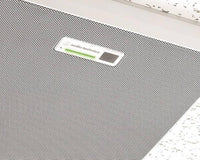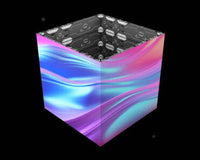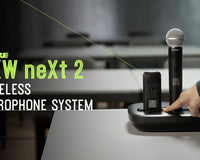Flat screens may get attention in conference rooms, but projector technology is quickly improving.

Projectors were the easiest way to display large images years ago, but flat screens and LCD-based digital whiteboards now dominate conference rooms and workplaces. Today, however. The projector is staging a comeback.
If you haven’t looked at projector technology recently, you might be surprised at how it’s improved in quality. But can these enhanced features transfer to the conference room? Here’s what IT leaders should know about the various projectors available today.
What Are Short-Throw Projectors? Are They Better than Big TVs?
Unlike regular projectors, short-throw projectors can display large images at a closer distance, generally between 3 to 8 feet away from a screen or surface. According to Epson’s projector guide, they are known for reducing “shadows and eye glare.”
Short-throw projectors take this technology a step further. They display images at up to 4 feet. Both projector types can be installed on a wall, ceiling, or table.
Projectors are defined by several different features, such as the technology they use to display images, the brightness of the resulting image, and the projector's proximity to the wall.
The distance required to display an image at a specific size is known as the “throw.” Epson’s positioning guide explains that the “projector position and the size of the image will depend upon your room configuration. Therefore, you must consider the throw distance and the projector features that will give you placement flexibility.”
Projectors predate modern day flat-screens. They are more closely associated with the cathode ray tube, says Bob Wudeck, senior director of business development for BenQ, a display technology manufacturer.
“There are different ways people are using projectors. They are trying to make projectors more like smartphones,” he says.
Short-throw projectors have some notable distinctions. For one, their ability to display images from shorter distances makes them easier to install in various settings.

What Are Ultra-Short-Throw Projectors? What Are Their Benefits?
Ultra-short-throw projectors take the basic concept of the short-throw projector even further. These projectors can display large images from a short distance. Epson notes that an 80-inch image can be generated from 50 centimeters (about 20 inches) away. Despite the distance, which can cause an unclear image, this type of projector keeps the quality clear and in focus.
Harkening back to earlier eras of computing, ultra-short-throw technology was the centerpiece for an interactive whiteboard that integrated touch input with a projector. In this arrangement, the projector was traditionally located above the whiteboard.
But in recent years, the technology’s positioning has shifted, and it is now being sold in some markets as a high-end alternative to flat-screen televisions. At CES this year, Samsung showed off an 8K ultra-short-throw projector. Sold in size roughly comparable to a video game console, these home theater-style projectors are placed on a TV stand near the wall, where they can display large, vibrant images well beyond a traditional flat screen. At CES this year, Samsung showed off an 8K ultra-short-throw projector.
Ultra-short-throws can be helpful in business because they work in cramped spaces, where assembling a projector or large LCD screen might be difficult.
“Ultra-short-throw projectors are great if you’re in a huddle space where you don’t have six feet, you want to do a smaller projector, and you need to do a 100-inch display,” Wudeck says. “The ultra-short-throw is a straightforward way to do it because you can mount it directly on the wall.” That said, Wudeck warns that the interactivity is not as robust as that of a multitouch touch screen.
What Kinds of Projection Technology Are Available?
The first modern digital projector was invented in 1984 by Gene Dolgoff. Since then, projector technology has evolved into multiple options, only some of which function like the old overhead projectors you might remember from the classroom.
The most common types include:
- Lamp projection. This is the most common type, the type that Dolgoff invented. Over time, its weaknesses have emerged. Lamp projectors, which amplify the image displayed on an LCD screen to an extra-large size, use more energy and require regular maintenance, as the bulbs regularly need to be replaced.
- Laser projection. This variant can reproduce images on a screen using either blue light lasers or three red, green, and blue lasers. These projectors produce high-quality images but can get hot and face issues with dust particles.
- LED projection. This projector type uses light-emitting diodes to display an image on the screen. LEDs have proved to be one of the most critical modern innovations in projectors, and as a result, these projectors tend to be bright, high-fidelity, cooler in temperature, and smaller in size. Plus, they don’t need dust filters. “It’s guaranteed to work. It’s designed for 20 years of dust exposure,” Wudeck says.
Regardless of the type of projector you choose, maintenance concerns should factor into your decision-making — mainly if it will be used in a busy conference room.

Comparison of Image Quality and Brightness
With each iteration of technology, new features are rolled out, purportedly making displays noticeably better. Recent smartphones, for example, have increased refresh rates and have gotten significantly brighter in recent years, a product of their use of active-matrix organic light-emitting diode (AMOLED) technology.
Conference room display technology works the same way. Each generation of flat screens can display more comprehensive color ranges and resolutions than what might previously have been possible.
Projectors have also benefited from these new advancements. For example, LED and laser projectors can now display images at resolutions similar to modern televisions.
Wudeck says that most projectors built for an office environment are bright enough for indoor use; major deterrents are likely to be low-resolution screens with jagged edges. Projectors make these imperfections more noticeable because the number of pixels per inch is significantly lower than you might see on a smartphone or laptop. He suggests that a 1920x1080-pixel resolution is a reasonable floor for projector screens, with 4K being preferable.
“The two things that make the biggest difference in the meeting room are resolution and color accuracy,” Wudeck says. “There’s nothing more distracting than looking at a picture when the colors don’t look right.”
Cost and Installation Considerations
Nowadays, getting a large, noninteractive flat-screen television for a few hundred dollars is possible. Projectors tend to be more expensive, with some options selling at $2,000 or more. But these have several advantages over a flat-screen, such as weight and size.
Projectors can work well in presentation mode, says Wudeck, though he warns that lasers and lamps must be positioned carefully so that the light source doesn’t hurt the speaker’s eyes.
This is important to remember, as projectors may require adjustment to account for viewing angles and speaker positioning. Panasonic, a manufacturer of projectors, offers a calculator that can help you determine how to place a projector in a given room.
Which is Right for You?
Ultimately, deciding between a projector or a flat screen comes down to your needs. If direct interactivity with the screen is your goal — if you’re hoping to use the monitor as a touch screen or interactive whiteboard — a flat-screen television or monitor may make more sense, as LCD and OLED screens have outpaced projectors on the multitouch technology front.
But if you want to display the largest possible image at the highest fidelity, short-throw, and ultra-short-throw projectors are more beneficial, especially in smaller office settings. If you have a large conference room, consider an ultra-short-throw projector; try a traditional short-throw if it’s a smaller space. Regardless of the type, today’s projectors are easier to install, cost-efficient, and offer high-quality visuals.
Need help to figure out what makes the most sense for your conference room needs? Consider Creation Networks to help you build an ideal space for workplace collaboration.






